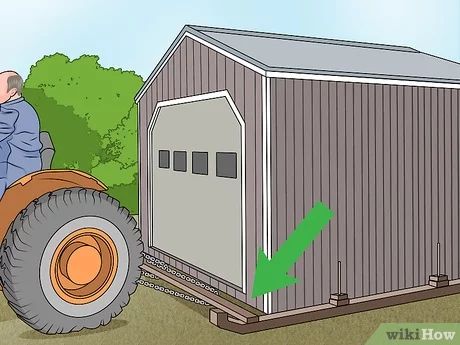Moving a shed by yourself can seem like a daunting task, but with some preparation and the right techniques, it is possible for one person to relocate a small to medium-sized shed. Here are some tips to help you move your shed solo.
Page Contents
Assess the shed
First, take a good look at the shed you need to move. Make note of the following:
- Size and weight – Estimate the dimensions and weight. A very small and lightweight plastic or resin shed may be light enough for one person to drag or roll on pipes. Most medium-sized wooden sheds will be too heavy for one person to lift and will need to be slid or rolled.
- Condition – Check for damage or rotting wood. Repair any major holes or cracks first so the shed holds together during the move.
- Contents – Remove everything stored inside the shed so all you have to move is the empty shed itself.
- Skids – See if the shed sits on skids or rails along the bottom. Skids make it much easier to drag the shed.
- Location – Note any obstacles in the old and new locations that will affect the move such as fences, trees, slopes, or soft ground.
If the shed is large (over 8′ x 8′), very heavy, or in poor condition, you will likely need to hire professional movers or recruit helpers. One person can only safely move a small to mid-sized sturdy wooden shed or a plastic resin shed up to 8′ x 10′ in size.
Choose your moving method
Once you have assessed the shed, decide which method you will use to move it. Options include:
- Dragging – If the shed sits on skids or rails, you may be able to drag it across the yard. This works best on flat, smooth surfaces.
- Rolling – Place pipes under the shed and roll it to the new spot. Secure the pipes so they don’t shift.
- Sliding – Build a ramp out of boards or steel sheets and slide the shed up onto a dolly or rollers to move it.
- Partial disassembly – Take apart some walls or the roof to lighten the load, then reassemble in the new location.
- Full disassembly – Completely disassemble the entire shed, move the pieces individually, then reassemble.
Consider which option makes the most sense based on the shed size, weight, construction, and condition, as well as the terrain it needs to move across.
Prepare the site
Now that you know how you’ll move the shed, prep both the current and new sites:
- Clear a path – Remove any obstacles or obstructions in the shed’s moving path between sites.
- Level the ground – Fill any dips or holes at the new site with gravel so it’s perfectly flat and solid.
- Install base – Build a new base if needed. Make sure it is level and able to bear the shed’s weight.
- Recruit helpers – If possible, have a few friends ready to assist with maneuvers once the shed is prepped for moving.
Prepare the shed
With both sites ready, now prepare the shed itself. This makes it easier and safer to move:
- Remove doors – Take doors off hinges so the open doorway provides an unobstructed moving path.
- Brace walls – Install temporary 2×4 braces extending from the bottom to top of each wall. This helps prevent racking and collapse.
- Detach anchor – If anchored or fixed to the current site, detach it completely so the shed is free-standing.
- Lift onto rollers – If rolling or sliding the shed, lift it onto pipes or rollers using jacks or your helpers.
Move that shed!
Now comes the tough part – it’s time to move that shed! Here are some tips to make it go smoothly:
- Lift safely – With helpers, lift from the knees using proper technique. Don’t injure your back!
- Control direction – Use ropes tied to the shed to pull and steer the shed where you want it to go.
- Watch for binding – If the shed gets stuck, check for obstructions under or around it. Put additional pipes or rollers under sticking points to keep it moving.
- Work slowly – Take your time and make small adjustments to maneuver around obstacles. Rushing will likely lead to damage.
- Use leverage – Use pry bars, long poles, or shovels to pry up stuck corners and leverage the shed free if it binds up.
Be prepared to take breaks. Hydrate and rest your muscles often – this is tough work! Having a few friends to help makes the job much easier.
Secure and protect the shed
Once the shed reaches its destination, secure and protect it:
- Remove rollers/pipes – If you rolled the shed, carefully lift and remove the rollers or pipes.
- Anchor shed – Bolt the shed to its new base according to the manufacturer’s instructions.
- Reinstall doors – Put the doors back on their hinges and test that they open properly.
- Seal up – Caulk any gaps that opened up during the move to keep out moisture.
- Grade soil – Grade and landscape the soil around the shed so water will drain away.
Do a final inspection to make sure the shed is level, plumb, and stable in its new home before loading your stuff back in!
Conclusion
With adequate preparation and some brute force, you can indeed move a small-to-medium sized shed successfully by yourself. Just be sure to use smart techniques, enlist some help when possible, and take it slow and steady. Your back and your shed will thank you!
